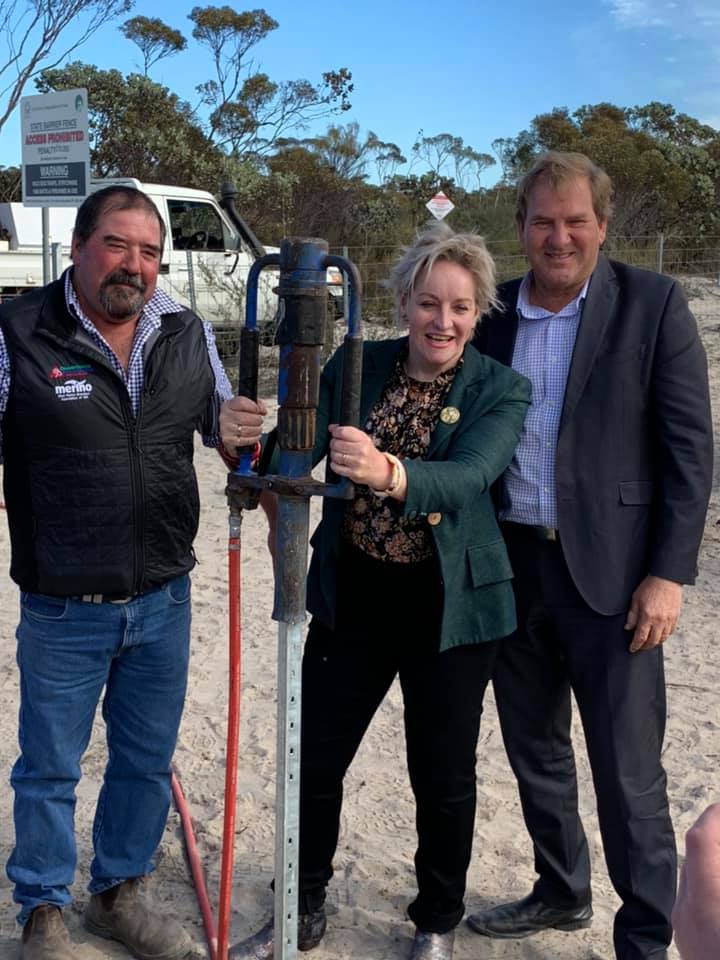6 June 2019
Scott Pickering has been a man on a mission for nearly two decades. So it’s no surprise that the exuberant WA farmer and his hardworking colleagues were jubilant when a 660km extension to the 1170km WA State Barrier Fence, and additional Federal funding were approved in April after 16 long years of lobbying.

For more than a century, WA’s State Barrier Fence (SBF) had played an important role in preventing animal pests such as wild dogs (also emus and kangaroos) from moving into the State’s agricultural areas from pastoral areas in the east. The fence currently spans 1170km from north of Kalbarri to east of Ravensthorpe.
However over the past 20 years, wild dog activity has increased adjacent to the SBF particularly since the Agriculture Protection Board (APB) control programs ceased in the late 1990s and government assistance was confined to annual aerial baiting on the large area of unoccupied Crown Lands. This led to an escalation in pest animal problems from 2000, compounded by the fact that the ageing SBF does not provide continuous protection. More information is available on the Esperance Biosecurity Association site.
Prompted by escalating sheep attacks in the early 2000s, Scott and other landholders adjacent to the SBF hired a retired dog controller for a ‘quick fix’ but the the problem was too widespread and the solution required better coordination and funding. Nor did it address the emu plague problems being faced by landholders.
According to Scott, up to 3000 sheep were lost in a year due to the wild dog build-up in Esperance Shire where farming land is essentially surrounded by Crown Land without a buffer zone between the two. Read more about the impacts of wild dogs.
Scott said: “We held a meeting in Salmon Gums to discuss the problem but we had little money or resources. We had nowhere else to turn so an action group was formed by farmers for farmers and it snowballed from there.” Scott still chairs what was originally the Northern Mallee Declared Species Group (NMDSG), now transitioned into the Esperance Biosecurity Association (EBA) for the purpose of controlling declared pests in the Esperance Shire.
The first declared species group (NMDSG) in WA came together in 2003 because there was no other option for wild dog control. It immediately started lobbying for government support to extend the existing SBF thus creating a continuous barrier to wild dogs, (kangaroos and emus) between the farming communities to the south of the fence and Crown Lands to the north. Read an overview.
The actual Esperance Extension Barrier Fence Committee started work in 2007 and invited National Wild Dog Action Plan Coordinator, Greg Mifsud to join them in 2009 to establish a control plan for the NMDSG and reinforce the importance of putting a physical barrier in place. Greg could see that due to the nature of the landscape (such as abundant uncleared land and timbered corridors) and the existing breaches in the SBF there was real potential for wild dogs to infiltrate the farming country and cause far greater impacts to producers closer to the coast.
Not only did Greg provide training to raise awareness and the capacity of landholders to undertake baiting programs themselves and to understand the need for landscape-scale control, but he also provided wild dog management advice to support the Group’s case. He explained how the SBF extension would improve the confidence of sheep producers to increase their flock sizes and graze country that previously hadn’t been used for fear of wild dog attacks.
The economic flow-on effects from an expanding sheep and wool industry to the region are massive.
Scott details some other challenges: “We’re now on our sixth Ag Minister!
We had to undergo Environmental Impact Statements (EIS) and get approvals to fence. We had issues dealing with different government departments. We had to change the alignment of the fence to satisfy the Environment Protection Authority (EPA) and to avoid culturally sensitive areas. It made the fence a bit longer but eventually we managed to appease everyone in the high-risk areas. We were told many times it could never happen, but I was determined, and became a relentless lobbyist. We lobbied the Federal Minister for Agriculture long and hard as well as our local member of parliament.
“We’re adding 660km to make the SBF 1830km in total. 118km of the extension is on private property – 270km on road reserves – and the rest is subject to Native Title. So it’s been a slow process.
“If you stick at it long enough and believe it enough, you’ll get there. Despite the fence project being put through as much red tape as a uranium mine, we’ve had minimal turnover on our Committee.”
Funding for the SBF extension is multi-agency. Esperance Shire’s $1.5million contribution includes building road grids where the fence stops. $280,000 from Ravensthorpe Shire and $205,000 from AWI will go to acquiring fence building machinery and equipment. WA State Government will cover any funding shortfall.
Scott Pickering kept asking: Why does the rest of the state have a barrier fence and we don’t?
He said: “12 months ago were just about to pull out and hand it back to the Ag Department, we were getting so despondent. But Esperance is the most reliable farming land in WA. The Cost Benefit Analysis of this fence is overwhelming! 7:1 with the current price of wool/livestock.”
Additional benefits include the local economy receiving a revenue injection during the survey and construction period, and a firebreak being maintained along the fenceline.
Smaller natives animals can move freely through the fence and environmental studies suggest little adverse impact on non-target native species.
“So we just kept pushing for it. Sixteen years and six Ag Ministers later we got there through all the red tape! So never ever give up! But the biggest ‘take home’ message is it gives people the confidence to go back into livestock.”
More details are available on Esperance Biosecurity Association’s FAQ page.

Share